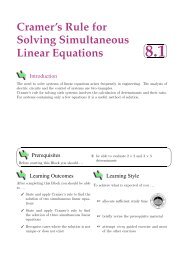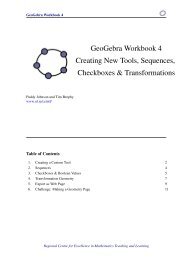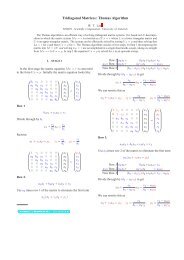Student Notes To Accompany MS4214: STATISTICAL INFERENCE
Student Notes To Accompany MS4214: STATISTICAL INFERENCE
Student Notes To Accompany MS4214: STATISTICAL INFERENCE
Create successful ePaper yourself
Turn your PDF publications into a flip-book with our unique Google optimized e-Paper software.
a0 b0 a ∗ b ∗ Steps Eigenvalues<br />
1.8 74.5 1.924941 78.12213 4 all positive<br />
2.36 72 1.924941 78.12213 5 all positive<br />
2 70 1.924941 78.12213 5 all positive<br />
1 2 1.924941 78.12213 15 all positive<br />
80 1 1.924941 78.12213 387 all positive<br />
2 100 4.292059 −34.591322 2 crashed<br />
Table 2.6.1: Newton-Raphson estimates of the Weibull parameters.<br />
Given initial values a0 and b0 equation (2.8) can be used to obtained updated estimates<br />
via<br />
�<br />
anew<br />
bnew<br />
�<br />
=<br />
�<br />
a0<br />
b0<br />
�<br />
+<br />
�<br />
Iaa(a0, b0) Iab(a0, b0)<br />
Iba(a0, b0) Ibb(a0, b0)<br />
� −1 �<br />
Sa(a0, b0)<br />
Sb(a0, b0)<br />
�<br />
. (2.9)<br />
Having solved for a and b we check that a maximum has been achieved by calculating<br />
I(a ∗ , b ∗ ) and verifying that both of its eigenvalues are positive.<br />
Suppose n = 10 and m = 8 items fail at times 17, 29, 32, 55, 61, 74, 77, 93 (in hours)<br />
with the remaining two items surviving the 100 hour test. Table 2.6.1 shows estimates<br />
(a ∗ , b ∗ ) obtained from equation (2.9) using various starting values (a0, b0) along with<br />
the number of iteration steps taken until convergence using ɛ = 0.000001. Four of<br />
the starting pairs considered converged to estimates a ∗ = 1.924941 and b ∗ = 78.12213<br />
for a and b. The starting pairs (1, 2) and (80, 1) might misleadingly suggest that the<br />
algorithm is robust to the choice of starting values. However, the starting pair (2, 100)<br />
produced a negative estimate of b, and as ln(b) is required in the computation of the<br />
score function, caused the algorithm to crash. Other starting pairs not reported failed<br />
to yield estimates due to a non-invertible I(θ0) matrix being produced during the<br />
running of the algorithm. The remainder of this section describes commonly applied<br />
modifications of the Newton-Raphson method.<br />
Initial values<br />
The Newton-Raphson method depends on the initial guess being close to the true value.<br />
If this requirement is not satisfied the procedure might convergence to a minimum<br />
instead of a maximum, or just simply diverge and fail to produce any estimates at all.<br />
Methods of finding good initial estimates depend very much on the problem at hand<br />
and may require some ingenuity.<br />
The distribution function of a Weibull random variable T can be linearized as<br />
ln(− ln[1 − F (t)]) = −a ln(b) + a ln(t).<br />
35






